Taxation Law 11: Capital Gains, Depreciation, and Tax Concessions
VerifiedAdded on 2022/11/10
|12
|2821
|413
Homework Assignment
AI Summary
This document presents a comprehensive solution to a taxation law assignment, addressing key concepts such as capital gains tax (CGT), depreciation, and small business concessions. The solution analyzes various scenarios, including the sale of a main residence, personal use assets (PUAs) like cars and furniture, and the application of small business CGT concessions. It also examines the treatment of collectables like paintings. The assignment further delves into depreciation rules, specifically concerning depreciating assets like an industrial CNC machine, and the associated costs including purchase price, installation, and improvements. The solution references relevant sections of the Income Tax Assessment Act 1997 (ITAA 1997) and case law to support its arguments, providing a detailed and practical understanding of taxation principles.
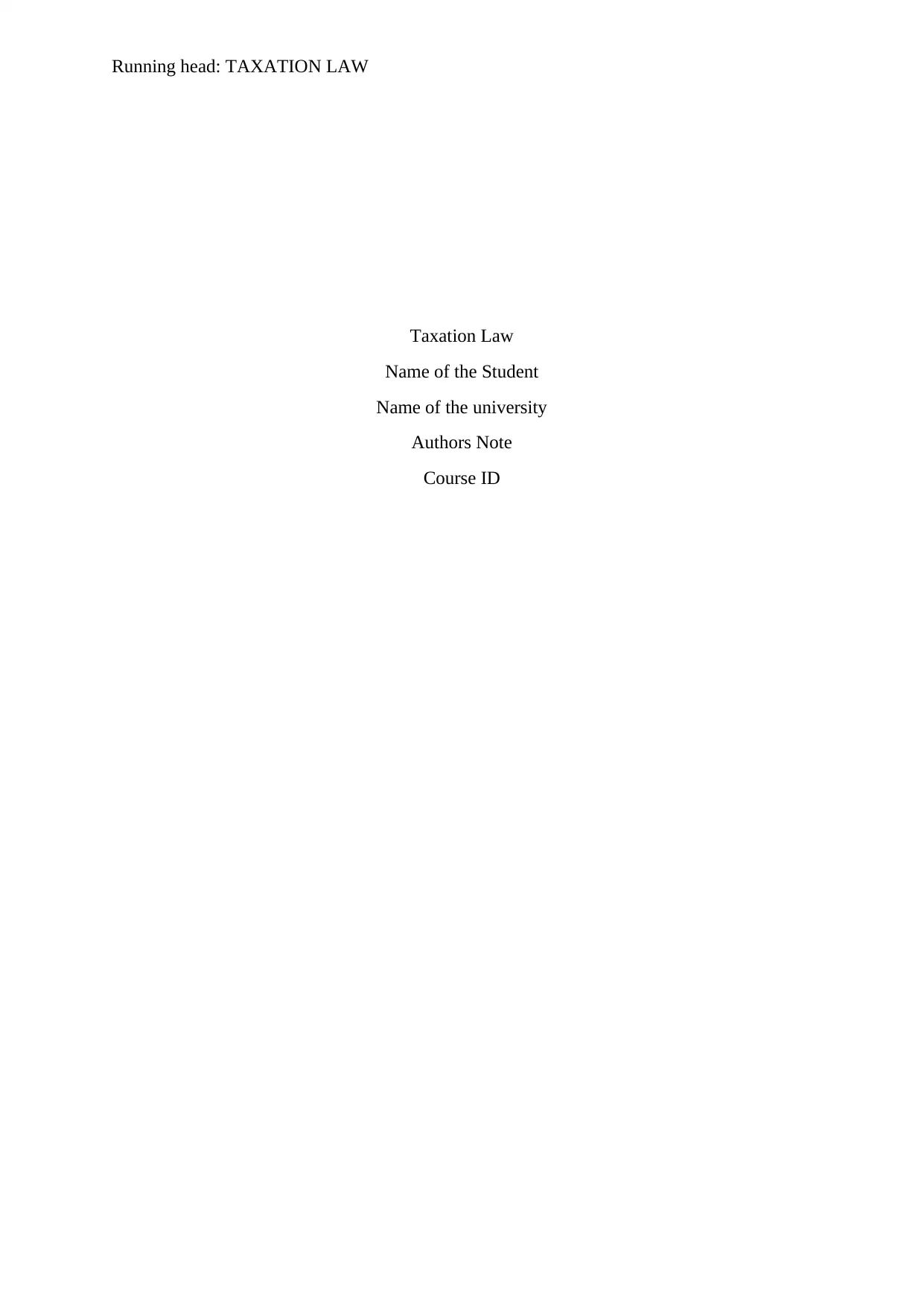
Running head: TAXATION LAW
Taxation Law
Name of the Student
Name of the university
Authors Note
Course ID
Taxation Law
Name of the Student
Name of the university
Authors Note
Course ID
Paraphrase This Document
Need a fresh take? Get an instant paraphrase of this document with our AI Paraphraser
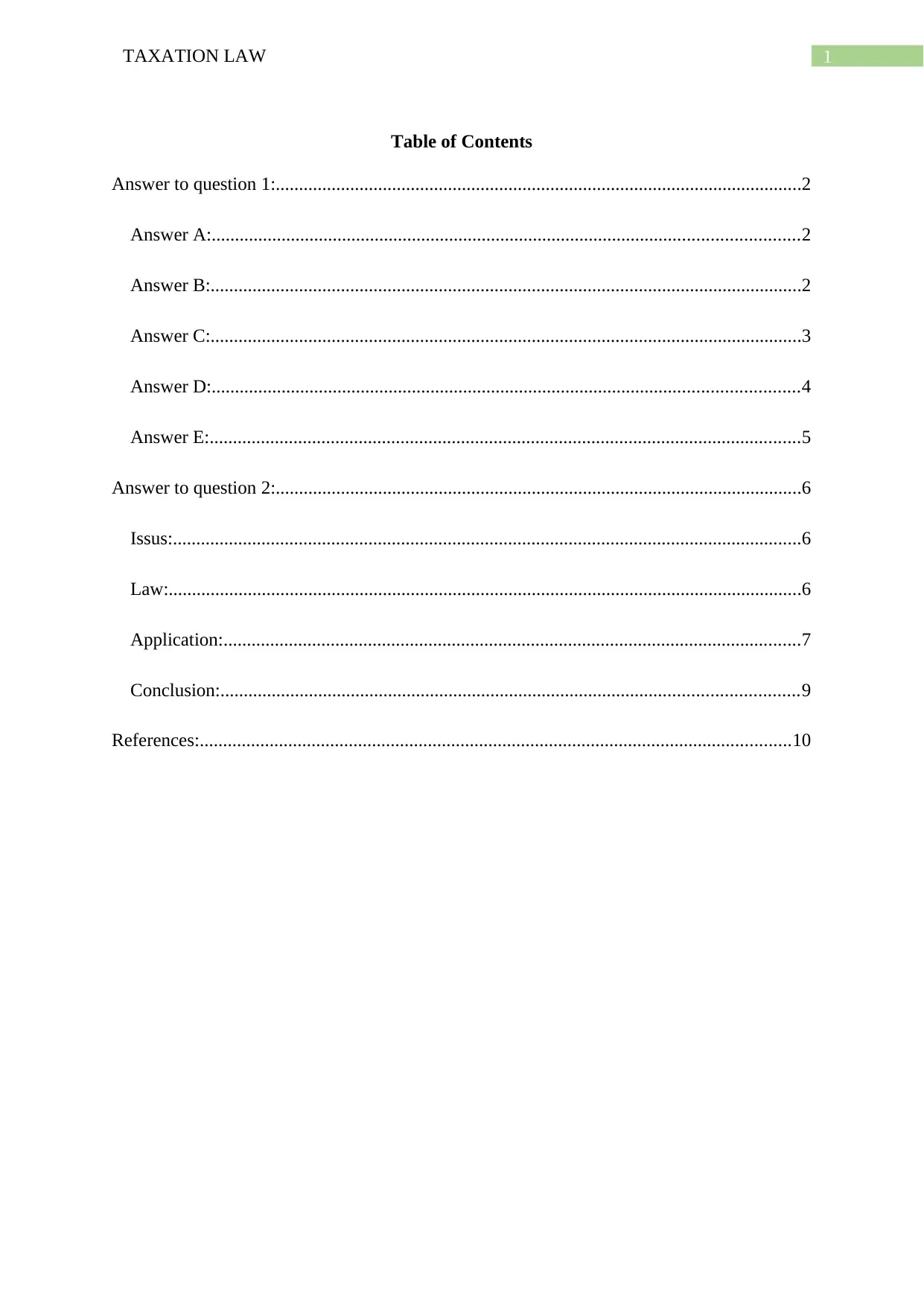
1TAXATION LAW
Table of Contents
Answer to question 1:.................................................................................................................2
Answer A:..............................................................................................................................2
Answer B:...............................................................................................................................2
Answer C:...............................................................................................................................3
Answer D:..............................................................................................................................4
Answer E:...............................................................................................................................5
Answer to question 2:.................................................................................................................6
Issus:.......................................................................................................................................6
Law:........................................................................................................................................6
Application:............................................................................................................................7
Conclusion:............................................................................................................................9
References:...............................................................................................................................10
Table of Contents
Answer to question 1:.................................................................................................................2
Answer A:..............................................................................................................................2
Answer B:...............................................................................................................................2
Answer C:...............................................................................................................................3
Answer D:..............................................................................................................................4
Answer E:...............................................................................................................................5
Answer to question 2:.................................................................................................................6
Issus:.......................................................................................................................................6
Law:........................................................................................................................................6
Application:............................................................................................................................7
Conclusion:............................................................................................................................9
References:...............................................................................................................................10
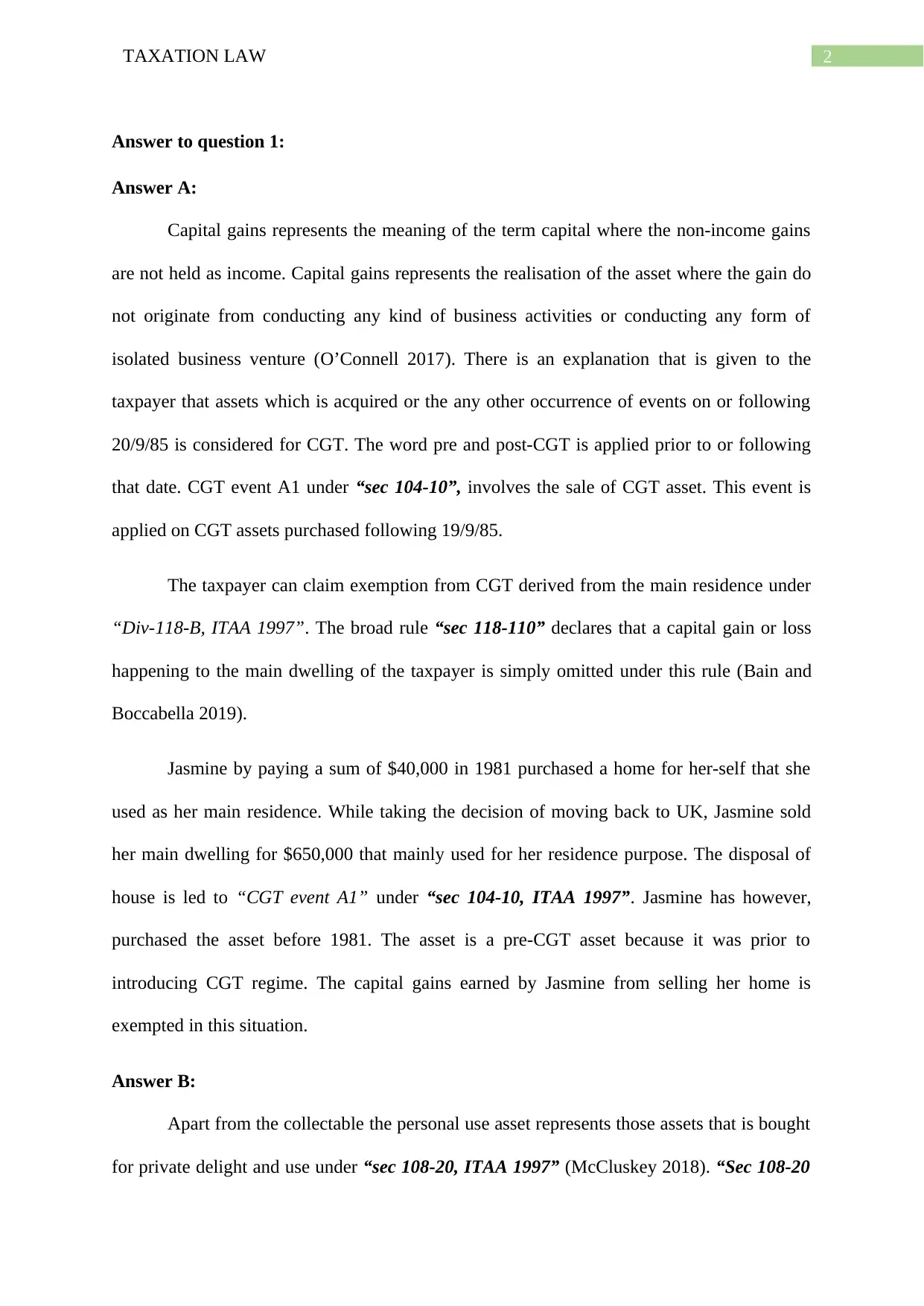
2TAXATION LAW
Answer to question 1:
Answer A:
Capital gains represents the meaning of the term capital where the non-income gains
are not held as income. Capital gains represents the realisation of the asset where the gain do
not originate from conducting any kind of business activities or conducting any form of
isolated business venture (O’Connell 2017). There is an explanation that is given to the
taxpayer that assets which is acquired or the any other occurrence of events on or following
20/9/85 is considered for CGT. The word pre and post-CGT is applied prior to or following
that date. CGT event A1 under “sec 104-10”, involves the sale of CGT asset. This event is
applied on CGT assets purchased following 19/9/85.
The taxpayer can claim exemption from CGT derived from the main residence under
“Div-118-B, ITAA 1997”. The broad rule “sec 118-110” declares that a capital gain or loss
happening to the main dwelling of the taxpayer is simply omitted under this rule (Bain and
Boccabella 2019).
Jasmine by paying a sum of $40,000 in 1981 purchased a home for her-self that she
used as her main residence. While taking the decision of moving back to UK, Jasmine sold
her main dwelling for $650,000 that mainly used for her residence purpose. The disposal of
house is led to “CGT event A1” under “sec 104-10, ITAA 1997”. Jasmine has however,
purchased the asset before 1981. The asset is a pre-CGT asset because it was prior to
introducing CGT regime. The capital gains earned by Jasmine from selling her home is
exempted in this situation.
Answer B:
Apart from the collectable the personal use asset represents those assets that is bought
for private delight and use under “sec 108-20, ITAA 1997” (McCluskey 2018). “Sec 108-20
Answer to question 1:
Answer A:
Capital gains represents the meaning of the term capital where the non-income gains
are not held as income. Capital gains represents the realisation of the asset where the gain do
not originate from conducting any kind of business activities or conducting any form of
isolated business venture (O’Connell 2017). There is an explanation that is given to the
taxpayer that assets which is acquired or the any other occurrence of events on or following
20/9/85 is considered for CGT. The word pre and post-CGT is applied prior to or following
that date. CGT event A1 under “sec 104-10”, involves the sale of CGT asset. This event is
applied on CGT assets purchased following 19/9/85.
The taxpayer can claim exemption from CGT derived from the main residence under
“Div-118-B, ITAA 1997”. The broad rule “sec 118-110” declares that a capital gain or loss
happening to the main dwelling of the taxpayer is simply omitted under this rule (Bain and
Boccabella 2019).
Jasmine by paying a sum of $40,000 in 1981 purchased a home for her-self that she
used as her main residence. While taking the decision of moving back to UK, Jasmine sold
her main dwelling for $650,000 that mainly used for her residence purpose. The disposal of
house is led to “CGT event A1” under “sec 104-10, ITAA 1997”. Jasmine has however,
purchased the asset before 1981. The asset is a pre-CGT asset because it was prior to
introducing CGT regime. The capital gains earned by Jasmine from selling her home is
exempted in this situation.
Answer B:
Apart from the collectable the personal use asset represents those assets that is bought
for private delight and use under “sec 108-20, ITAA 1997” (McCluskey 2018). “Sec 108-20
⊘ This is a preview!⊘
Do you want full access?
Subscribe today to unlock all pages.

Trusted by 1+ million students worldwide
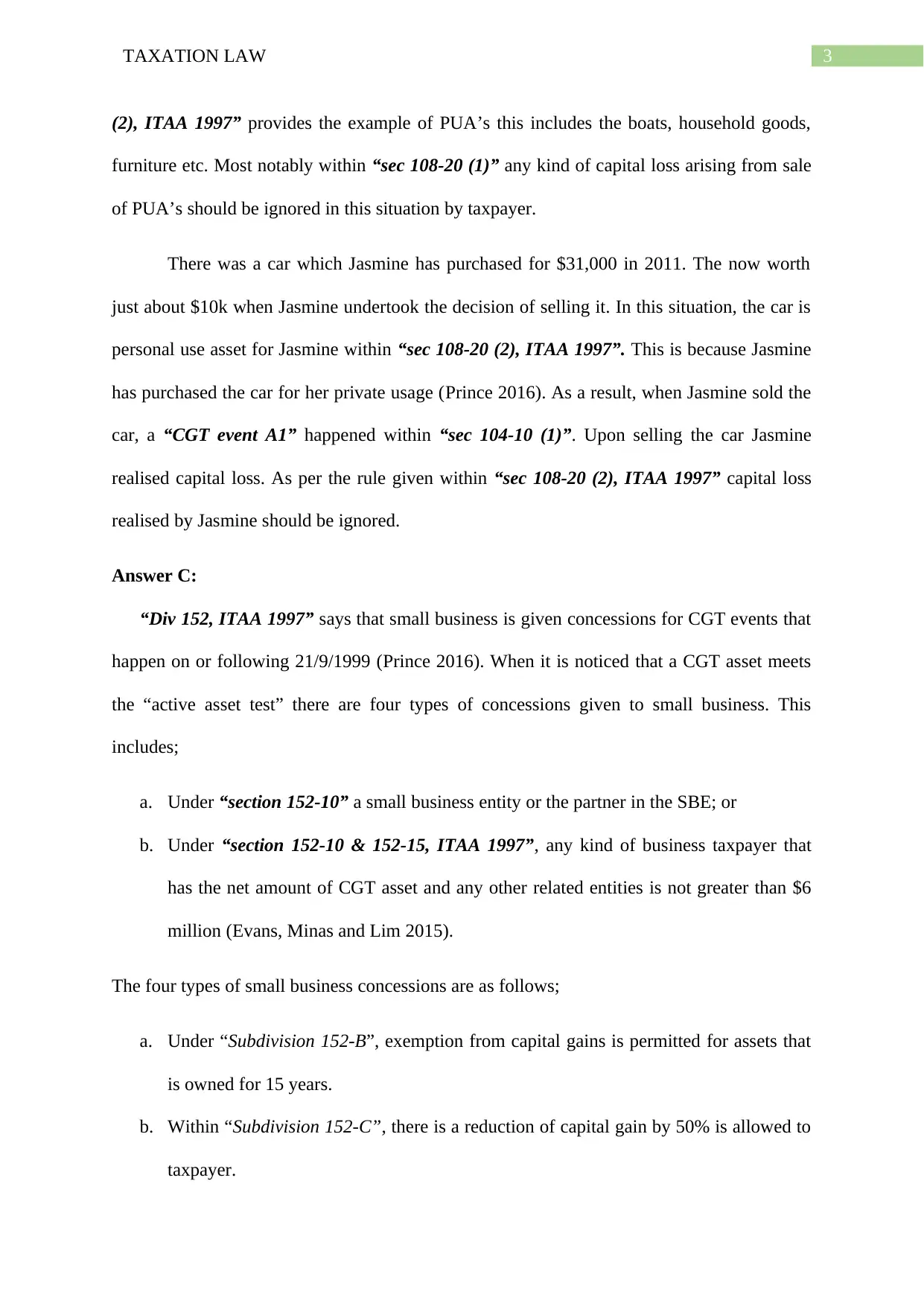
3TAXATION LAW
(2), ITAA 1997” provides the example of PUA’s this includes the boats, household goods,
furniture etc. Most notably within “sec 108-20 (1)” any kind of capital loss arising from sale
of PUA’s should be ignored in this situation by taxpayer.
There was a car which Jasmine has purchased for $31,000 in 2011. The now worth
just about $10k when Jasmine undertook the decision of selling it. In this situation, the car is
personal use asset for Jasmine within “sec 108-20 (2), ITAA 1997”. This is because Jasmine
has purchased the car for her private usage (Prince 2016). As a result, when Jasmine sold the
car, a “CGT event A1” happened within “sec 104-10 (1)”. Upon selling the car Jasmine
realised capital loss. As per the rule given within “sec 108-20 (2), ITAA 1997” capital loss
realised by Jasmine should be ignored.
Answer C:
“Div 152, ITAA 1997” says that small business is given concessions for CGT events that
happen on or following 21/9/1999 (Prince 2016). When it is noticed that a CGT asset meets
the “active asset test” there are four types of concessions given to small business. This
includes;
a. Under “section 152-10” a small business entity or the partner in the SBE; or
b. Under “section 152-10 & 152-15, ITAA 1997”, any kind of business taxpayer that
has the net amount of CGT asset and any other related entities is not greater than $6
million (Evans, Minas and Lim 2015).
The four types of small business concessions are as follows;
a. Under “Subdivision 152-B”, exemption from capital gains is permitted for assets that
is owned for 15 years.
b. Within “Subdivision 152-C”, there is a reduction of capital gain by 50% is allowed to
taxpayer.
(2), ITAA 1997” provides the example of PUA’s this includes the boats, household goods,
furniture etc. Most notably within “sec 108-20 (1)” any kind of capital loss arising from sale
of PUA’s should be ignored in this situation by taxpayer.
There was a car which Jasmine has purchased for $31,000 in 2011. The now worth
just about $10k when Jasmine undertook the decision of selling it. In this situation, the car is
personal use asset for Jasmine within “sec 108-20 (2), ITAA 1997”. This is because Jasmine
has purchased the car for her private usage (Prince 2016). As a result, when Jasmine sold the
car, a “CGT event A1” happened within “sec 104-10 (1)”. Upon selling the car Jasmine
realised capital loss. As per the rule given within “sec 108-20 (2), ITAA 1997” capital loss
realised by Jasmine should be ignored.
Answer C:
“Div 152, ITAA 1997” says that small business is given concessions for CGT events that
happen on or following 21/9/1999 (Prince 2016). When it is noticed that a CGT asset meets
the “active asset test” there are four types of concessions given to small business. This
includes;
a. Under “section 152-10” a small business entity or the partner in the SBE; or
b. Under “section 152-10 & 152-15, ITAA 1997”, any kind of business taxpayer that
has the net amount of CGT asset and any other related entities is not greater than $6
million (Evans, Minas and Lim 2015).
The four types of small business concessions are as follows;
a. Under “Subdivision 152-B”, exemption from capital gains is permitted for assets that
is owned for 15 years.
b. Within “Subdivision 152-C”, there is a reduction of capital gain by 50% is allowed to
taxpayer.
Paraphrase This Document
Need a fresh take? Get an instant paraphrase of this document with our AI Paraphraser
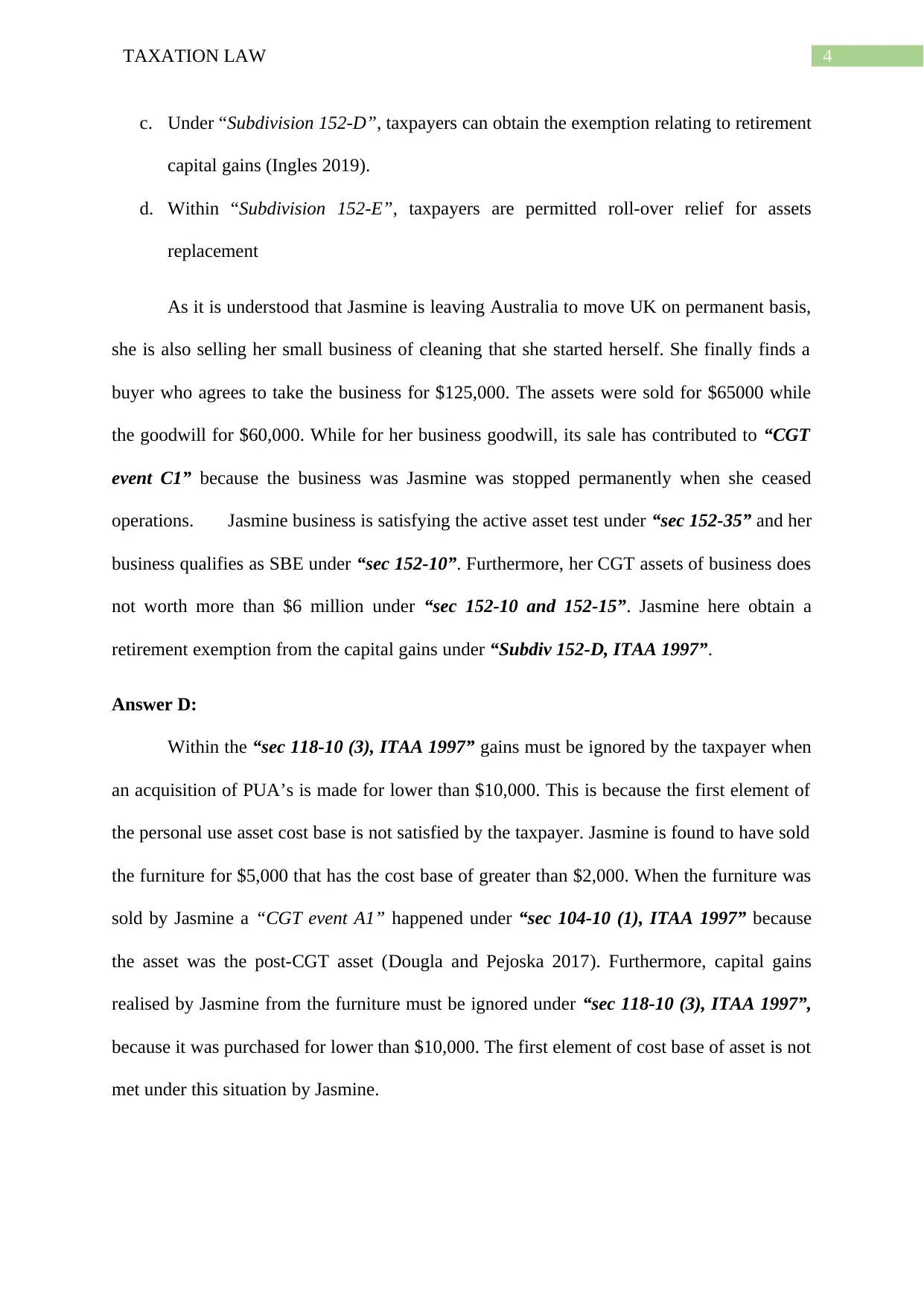
4TAXATION LAW
c. Under “Subdivision 152-D”, taxpayers can obtain the exemption relating to retirement
capital gains (Ingles 2019).
d. Within “Subdivision 152-E”, taxpayers are permitted roll-over relief for assets
replacement
As it is understood that Jasmine is leaving Australia to move UK on permanent basis,
she is also selling her small business of cleaning that she started herself. She finally finds a
buyer who agrees to take the business for $125,000. The assets were sold for $65000 while
the goodwill for $60,000. While for her business goodwill, its sale has contributed to “CGT
event C1” because the business was Jasmine was stopped permanently when she ceased
operations. Jasmine business is satisfying the active asset test under “sec 152-35” and her
business qualifies as SBE under “sec 152-10”. Furthermore, her CGT assets of business does
not worth more than $6 million under “sec 152-10 and 152-15”. Jasmine here obtain a
retirement exemption from the capital gains under “Subdiv 152-D, ITAA 1997”.
Answer D:
Within the “sec 118-10 (3), ITAA 1997” gains must be ignored by the taxpayer when
an acquisition of PUA’s is made for lower than $10,000. This is because the first element of
the personal use asset cost base is not satisfied by the taxpayer. Jasmine is found to have sold
the furniture for $5,000 that has the cost base of greater than $2,000. When the furniture was
sold by Jasmine a “CGT event A1” happened under “sec 104-10 (1), ITAA 1997” because
the asset was the post-CGT asset (Dougla and Pejoska 2017). Furthermore, capital gains
realised by Jasmine from the furniture must be ignored under “sec 118-10 (3), ITAA 1997”,
because it was purchased for lower than $10,000. The first element of cost base of asset is not
met under this situation by Jasmine.
c. Under “Subdivision 152-D”, taxpayers can obtain the exemption relating to retirement
capital gains (Ingles 2019).
d. Within “Subdivision 152-E”, taxpayers are permitted roll-over relief for assets
replacement
As it is understood that Jasmine is leaving Australia to move UK on permanent basis,
she is also selling her small business of cleaning that she started herself. She finally finds a
buyer who agrees to take the business for $125,000. The assets were sold for $65000 while
the goodwill for $60,000. While for her business goodwill, its sale has contributed to “CGT
event C1” because the business was Jasmine was stopped permanently when she ceased
operations. Jasmine business is satisfying the active asset test under “sec 152-35” and her
business qualifies as SBE under “sec 152-10”. Furthermore, her CGT assets of business does
not worth more than $6 million under “sec 152-10 and 152-15”. Jasmine here obtain a
retirement exemption from the capital gains under “Subdiv 152-D, ITAA 1997”.
Answer D:
Within the “sec 118-10 (3), ITAA 1997” gains must be ignored by the taxpayer when
an acquisition of PUA’s is made for lower than $10,000. This is because the first element of
the personal use asset cost base is not satisfied by the taxpayer. Jasmine is found to have sold
the furniture for $5,000 that has the cost base of greater than $2,000. When the furniture was
sold by Jasmine a “CGT event A1” happened under “sec 104-10 (1), ITAA 1997” because
the asset was the post-CGT asset (Dougla and Pejoska 2017). Furthermore, capital gains
realised by Jasmine from the furniture must be ignored under “sec 118-10 (3), ITAA 1997”,
because it was purchased for lower than $10,000. The first element of cost base of asset is not
met under this situation by Jasmine.
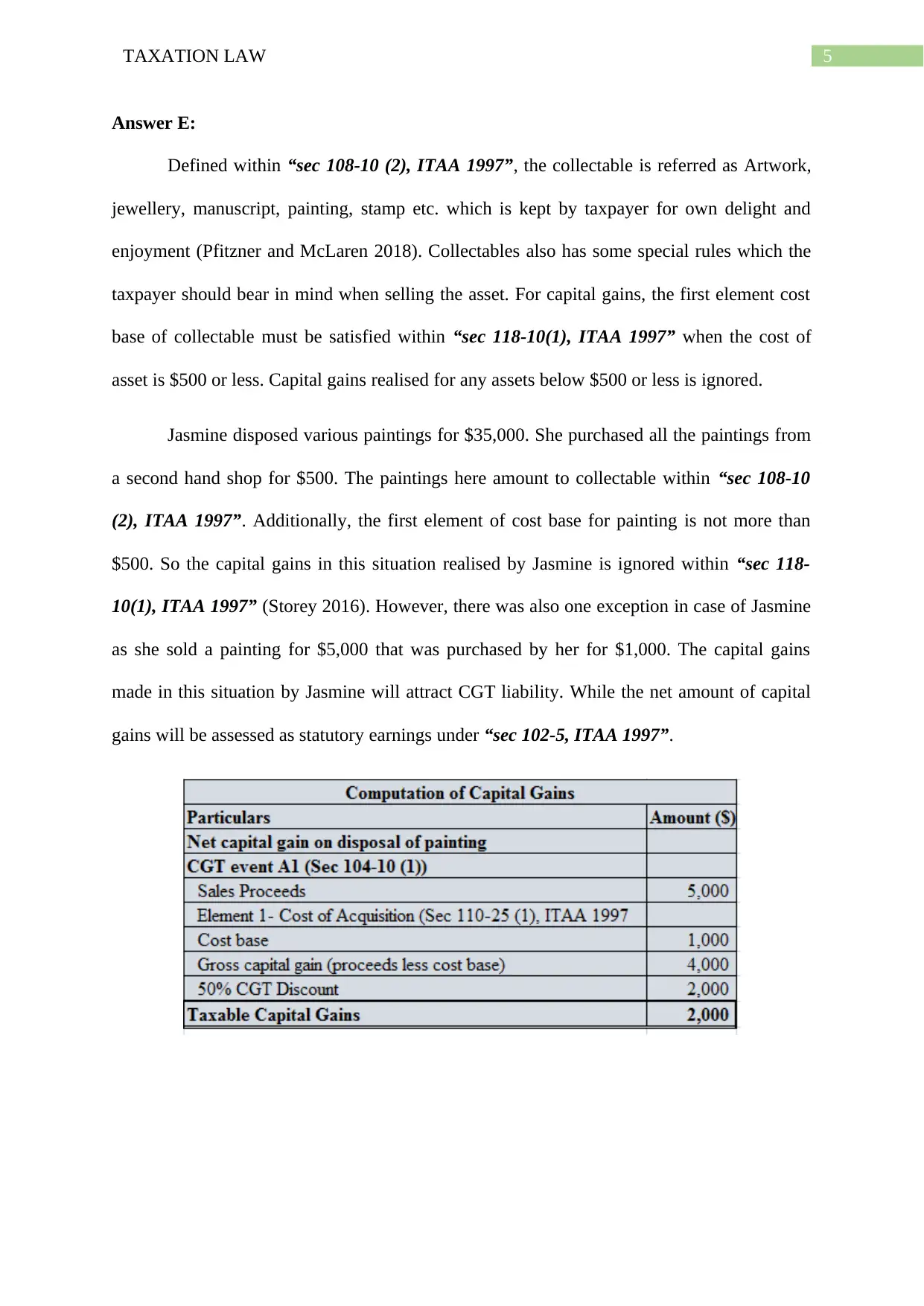
5TAXATION LAW
Answer E:
Defined within “sec 108-10 (2), ITAA 1997”, the collectable is referred as Artwork,
jewellery, manuscript, painting, stamp etc. which is kept by taxpayer for own delight and
enjoyment (Pfitzner and McLaren 2018). Collectables also has some special rules which the
taxpayer should bear in mind when selling the asset. For capital gains, the first element cost
base of collectable must be satisfied within “sec 118-10(1), ITAA 1997” when the cost of
asset is $500 or less. Capital gains realised for any assets below $500 or less is ignored.
Jasmine disposed various paintings for $35,000. She purchased all the paintings from
a second hand shop for $500. The paintings here amount to collectable within “sec 108-10
(2), ITAA 1997”. Additionally, the first element of cost base for painting is not more than
$500. So the capital gains in this situation realised by Jasmine is ignored within “sec 118-
10(1), ITAA 1997” (Storey 2016). However, there was also one exception in case of Jasmine
as she sold a painting for $5,000 that was purchased by her for $1,000. The capital gains
made in this situation by Jasmine will attract CGT liability. While the net amount of capital
gains will be assessed as statutory earnings under “sec 102-5, ITAA 1997”.
Answer E:
Defined within “sec 108-10 (2), ITAA 1997”, the collectable is referred as Artwork,
jewellery, manuscript, painting, stamp etc. which is kept by taxpayer for own delight and
enjoyment (Pfitzner and McLaren 2018). Collectables also has some special rules which the
taxpayer should bear in mind when selling the asset. For capital gains, the first element cost
base of collectable must be satisfied within “sec 118-10(1), ITAA 1997” when the cost of
asset is $500 or less. Capital gains realised for any assets below $500 or less is ignored.
Jasmine disposed various paintings for $35,000. She purchased all the paintings from
a second hand shop for $500. The paintings here amount to collectable within “sec 108-10
(2), ITAA 1997”. Additionally, the first element of cost base for painting is not more than
$500. So the capital gains in this situation realised by Jasmine is ignored within “sec 118-
10(1), ITAA 1997” (Storey 2016). However, there was also one exception in case of Jasmine
as she sold a painting for $5,000 that was purchased by her for $1,000. The capital gains
made in this situation by Jasmine will attract CGT liability. While the net amount of capital
gains will be assessed as statutory earnings under “sec 102-5, ITAA 1997”.
⊘ This is a preview!⊘
Do you want full access?
Subscribe today to unlock all pages.

Trusted by 1+ million students worldwide
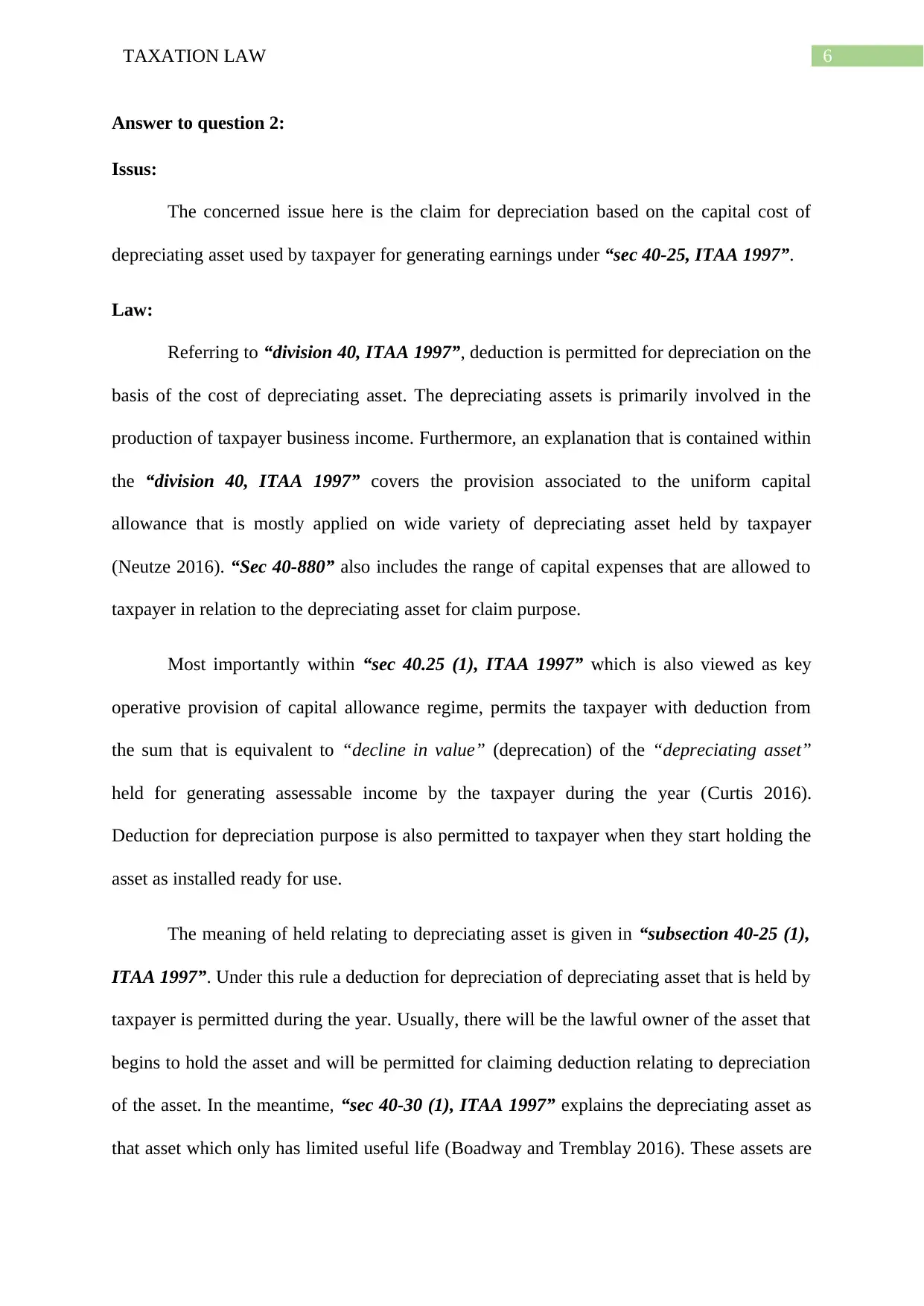
6TAXATION LAW
Answer to question 2:
Issus:
The concerned issue here is the claim for depreciation based on the capital cost of
depreciating asset used by taxpayer for generating earnings under “sec 40-25, ITAA 1997”.
Law:
Referring to “division 40, ITAA 1997”, deduction is permitted for depreciation on the
basis of the cost of depreciating asset. The depreciating assets is primarily involved in the
production of taxpayer business income. Furthermore, an explanation that is contained within
the “division 40, ITAA 1997” covers the provision associated to the uniform capital
allowance that is mostly applied on wide variety of depreciating asset held by taxpayer
(Neutze 2016). “Sec 40-880” also includes the range of capital expenses that are allowed to
taxpayer in relation to the depreciating asset for claim purpose.
Most importantly within “sec 40.25 (1), ITAA 1997” which is also viewed as key
operative provision of capital allowance regime, permits the taxpayer with deduction from
the sum that is equivalent to “decline in value” (deprecation) of the “depreciating asset”
held for generating assessable income by the taxpayer during the year (Curtis 2016).
Deduction for depreciation purpose is also permitted to taxpayer when they start holding the
asset as installed ready for use.
The meaning of held relating to depreciating asset is given in “subsection 40-25 (1),
ITAA 1997”. Under this rule a deduction for depreciation of depreciating asset that is held by
taxpayer is permitted during the year. Usually, there will be the lawful owner of the asset that
begins to hold the asset and will be permitted for claiming deduction relating to depreciation
of the asset. In the meantime, “sec 40-30 (1), ITAA 1997” explains the depreciating asset as
that asset which only has limited useful life (Boadway and Tremblay 2016). These assets are
Answer to question 2:
Issus:
The concerned issue here is the claim for depreciation based on the capital cost of
depreciating asset used by taxpayer for generating earnings under “sec 40-25, ITAA 1997”.
Law:
Referring to “division 40, ITAA 1997”, deduction is permitted for depreciation on the
basis of the cost of depreciating asset. The depreciating assets is primarily involved in the
production of taxpayer business income. Furthermore, an explanation that is contained within
the “division 40, ITAA 1997” covers the provision associated to the uniform capital
allowance that is mostly applied on wide variety of depreciating asset held by taxpayer
(Neutze 2016). “Sec 40-880” also includes the range of capital expenses that are allowed to
taxpayer in relation to the depreciating asset for claim purpose.
Most importantly within “sec 40.25 (1), ITAA 1997” which is also viewed as key
operative provision of capital allowance regime, permits the taxpayer with deduction from
the sum that is equivalent to “decline in value” (deprecation) of the “depreciating asset”
held for generating assessable income by the taxpayer during the year (Curtis 2016).
Deduction for depreciation purpose is also permitted to taxpayer when they start holding the
asset as installed ready for use.
The meaning of held relating to depreciating asset is given in “subsection 40-25 (1),
ITAA 1997”. Under this rule a deduction for depreciation of depreciating asset that is held by
taxpayer is permitted during the year. Usually, there will be the lawful owner of the asset that
begins to hold the asset and will be permitted for claiming deduction relating to depreciation
of the asset. In the meantime, “sec 40-30 (1), ITAA 1997” explains the depreciating asset as
that asset which only has limited useful life (Boadway and Tremblay 2016). These assets are
Paraphrase This Document
Need a fresh take? Get an instant paraphrase of this document with our AI Paraphraser
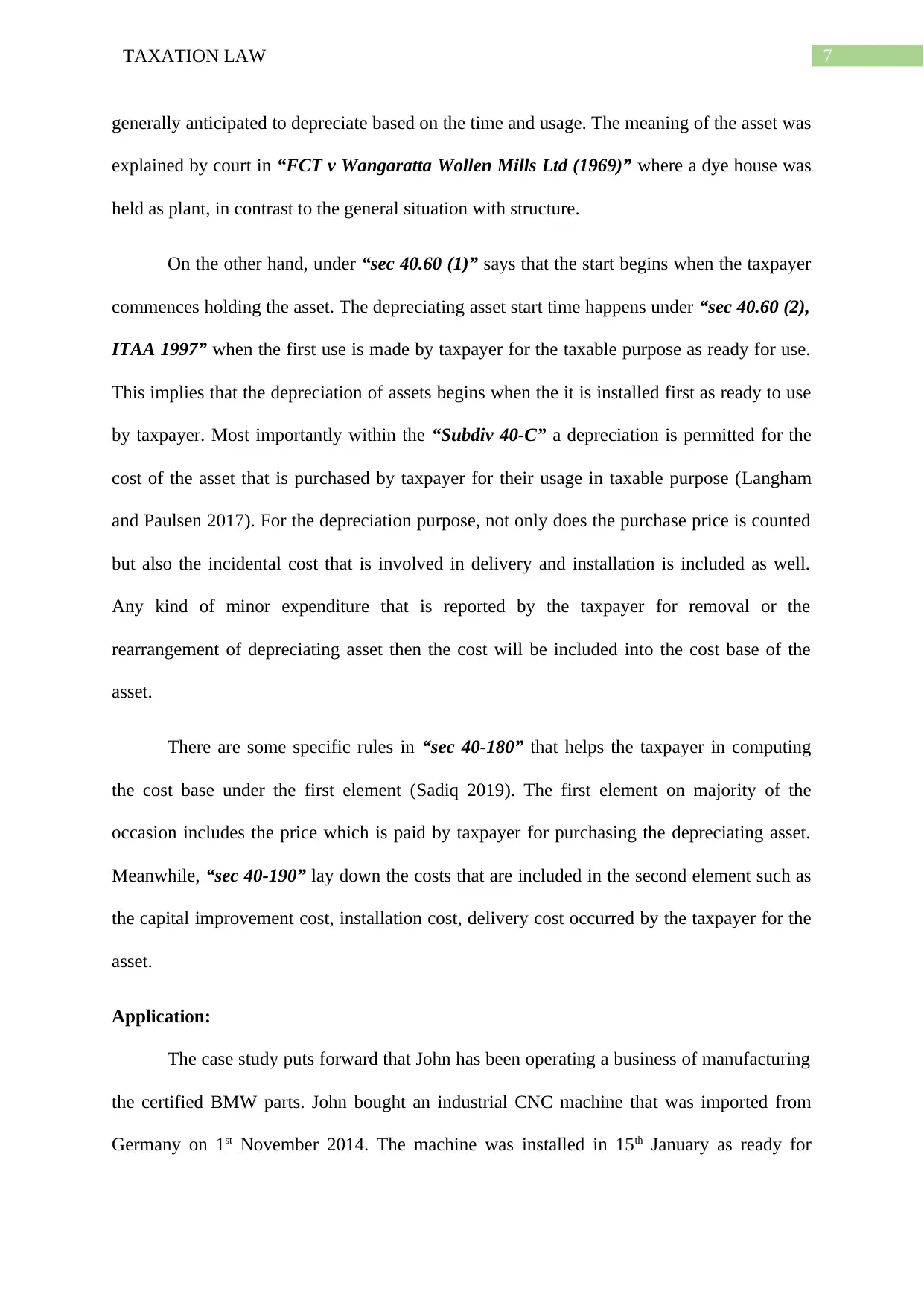
7TAXATION LAW
generally anticipated to depreciate based on the time and usage. The meaning of the asset was
explained by court in “FCT v Wangaratta Wollen Mills Ltd (1969)” where a dye house was
held as plant, in contrast to the general situation with structure.
On the other hand, under “sec 40.60 (1)” says that the start begins when the taxpayer
commences holding the asset. The depreciating asset start time happens under “sec 40.60 (2),
ITAA 1997” when the first use is made by taxpayer for the taxable purpose as ready for use.
This implies that the depreciation of assets begins when the it is installed first as ready to use
by taxpayer. Most importantly within the “Subdiv 40-C” a depreciation is permitted for the
cost of the asset that is purchased by taxpayer for their usage in taxable purpose (Langham
and Paulsen 2017). For the depreciation purpose, not only does the purchase price is counted
but also the incidental cost that is involved in delivery and installation is included as well.
Any kind of minor expenditure that is reported by the taxpayer for removal or the
rearrangement of depreciating asset then the cost will be included into the cost base of the
asset.
There are some specific rules in “sec 40-180” that helps the taxpayer in computing
the cost base under the first element (Sadiq 2019). The first element on majority of the
occasion includes the price which is paid by taxpayer for purchasing the depreciating asset.
Meanwhile, “sec 40-190” lay down the costs that are included in the second element such as
the capital improvement cost, installation cost, delivery cost occurred by the taxpayer for the
asset.
Application:
The case study puts forward that John has been operating a business of manufacturing
the certified BMW parts. John bought an industrial CNC machine that was imported from
Germany on 1st November 2014. The machine was installed in 15th January as ready for
generally anticipated to depreciate based on the time and usage. The meaning of the asset was
explained by court in “FCT v Wangaratta Wollen Mills Ltd (1969)” where a dye house was
held as plant, in contrast to the general situation with structure.
On the other hand, under “sec 40.60 (1)” says that the start begins when the taxpayer
commences holding the asset. The depreciating asset start time happens under “sec 40.60 (2),
ITAA 1997” when the first use is made by taxpayer for the taxable purpose as ready for use.
This implies that the depreciation of assets begins when the it is installed first as ready to use
by taxpayer. Most importantly within the “Subdiv 40-C” a depreciation is permitted for the
cost of the asset that is purchased by taxpayer for their usage in taxable purpose (Langham
and Paulsen 2017). For the depreciation purpose, not only does the purchase price is counted
but also the incidental cost that is involved in delivery and installation is included as well.
Any kind of minor expenditure that is reported by the taxpayer for removal or the
rearrangement of depreciating asset then the cost will be included into the cost base of the
asset.
There are some specific rules in “sec 40-180” that helps the taxpayer in computing
the cost base under the first element (Sadiq 2019). The first element on majority of the
occasion includes the price which is paid by taxpayer for purchasing the depreciating asset.
Meanwhile, “sec 40-190” lay down the costs that are included in the second element such as
the capital improvement cost, installation cost, delivery cost occurred by the taxpayer for the
asset.
Application:
The case study puts forward that John has been operating a business of manufacturing
the certified BMW parts. John bought an industrial CNC machine that was imported from
Germany on 1st November 2014. The machine was installed in 15th January as ready for
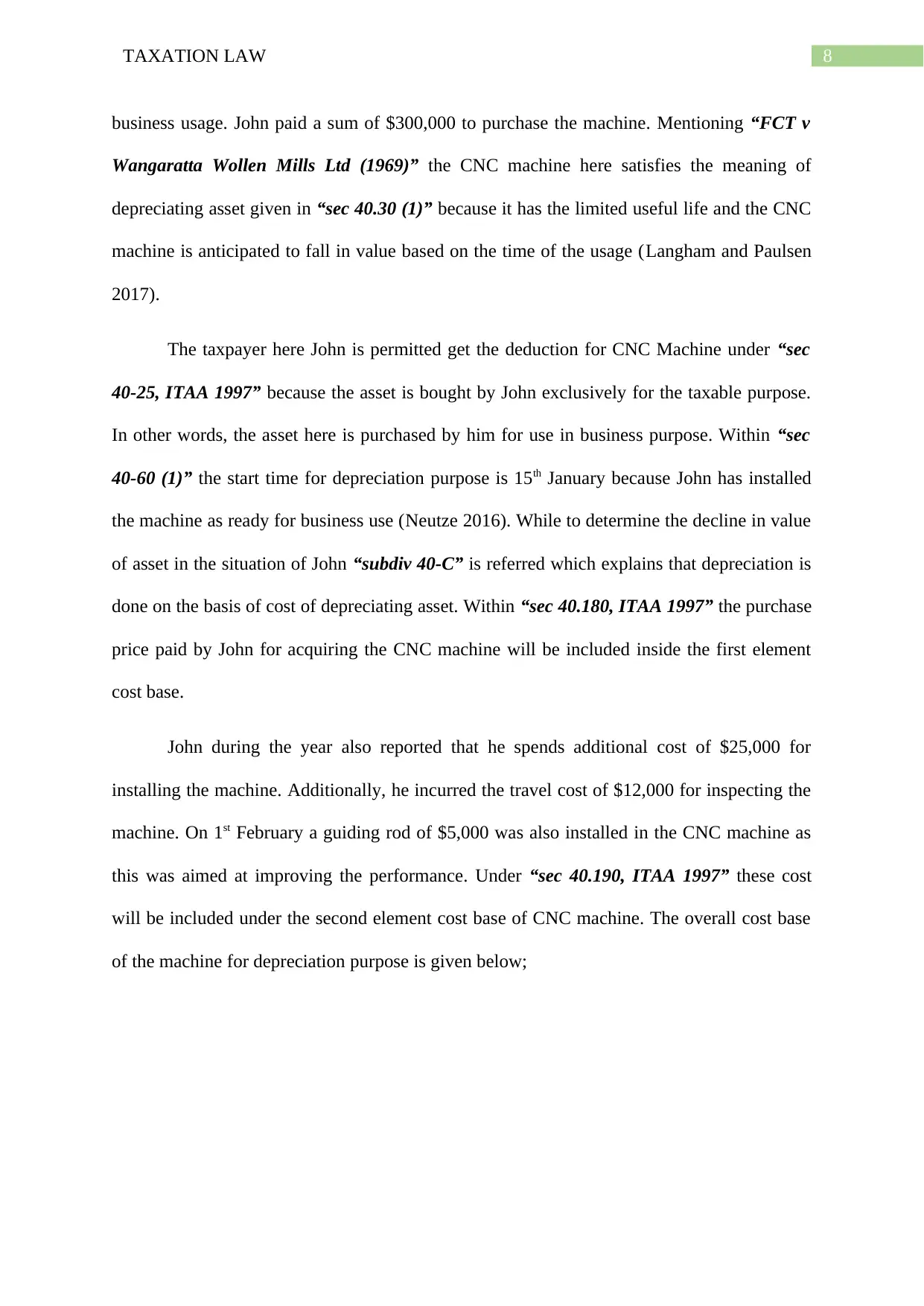
8TAXATION LAW
business usage. John paid a sum of $300,000 to purchase the machine. Mentioning “FCT v
Wangaratta Wollen Mills Ltd (1969)” the CNC machine here satisfies the meaning of
depreciating asset given in “sec 40.30 (1)” because it has the limited useful life and the CNC
machine is anticipated to fall in value based on the time of the usage (Langham and Paulsen
2017).
The taxpayer here John is permitted get the deduction for CNC Machine under “sec
40-25, ITAA 1997” because the asset is bought by John exclusively for the taxable purpose.
In other words, the asset here is purchased by him for use in business purpose. Within “sec
40-60 (1)” the start time for depreciation purpose is 15th January because John has installed
the machine as ready for business use (Neutze 2016). While to determine the decline in value
of asset in the situation of John “subdiv 40-C” is referred which explains that depreciation is
done on the basis of cost of depreciating asset. Within “sec 40.180, ITAA 1997” the purchase
price paid by John for acquiring the CNC machine will be included inside the first element
cost base.
John during the year also reported that he spends additional cost of $25,000 for
installing the machine. Additionally, he incurred the travel cost of $12,000 for inspecting the
machine. On 1st February a guiding rod of $5,000 was also installed in the CNC machine as
this was aimed at improving the performance. Under “sec 40.190, ITAA 1997” these cost
will be included under the second element cost base of CNC machine. The overall cost base
of the machine for depreciation purpose is given below;
business usage. John paid a sum of $300,000 to purchase the machine. Mentioning “FCT v
Wangaratta Wollen Mills Ltd (1969)” the CNC machine here satisfies the meaning of
depreciating asset given in “sec 40.30 (1)” because it has the limited useful life and the CNC
machine is anticipated to fall in value based on the time of the usage (Langham and Paulsen
2017).
The taxpayer here John is permitted get the deduction for CNC Machine under “sec
40-25, ITAA 1997” because the asset is bought by John exclusively for the taxable purpose.
In other words, the asset here is purchased by him for use in business purpose. Within “sec
40-60 (1)” the start time for depreciation purpose is 15th January because John has installed
the machine as ready for business use (Neutze 2016). While to determine the decline in value
of asset in the situation of John “subdiv 40-C” is referred which explains that depreciation is
done on the basis of cost of depreciating asset. Within “sec 40.180, ITAA 1997” the purchase
price paid by John for acquiring the CNC machine will be included inside the first element
cost base.
John during the year also reported that he spends additional cost of $25,000 for
installing the machine. Additionally, he incurred the travel cost of $12,000 for inspecting the
machine. On 1st February a guiding rod of $5,000 was also installed in the CNC machine as
this was aimed at improving the performance. Under “sec 40.190, ITAA 1997” these cost
will be included under the second element cost base of CNC machine. The overall cost base
of the machine for depreciation purpose is given below;
⊘ This is a preview!⊘
Do you want full access?
Subscribe today to unlock all pages.

Trusted by 1+ million students worldwide
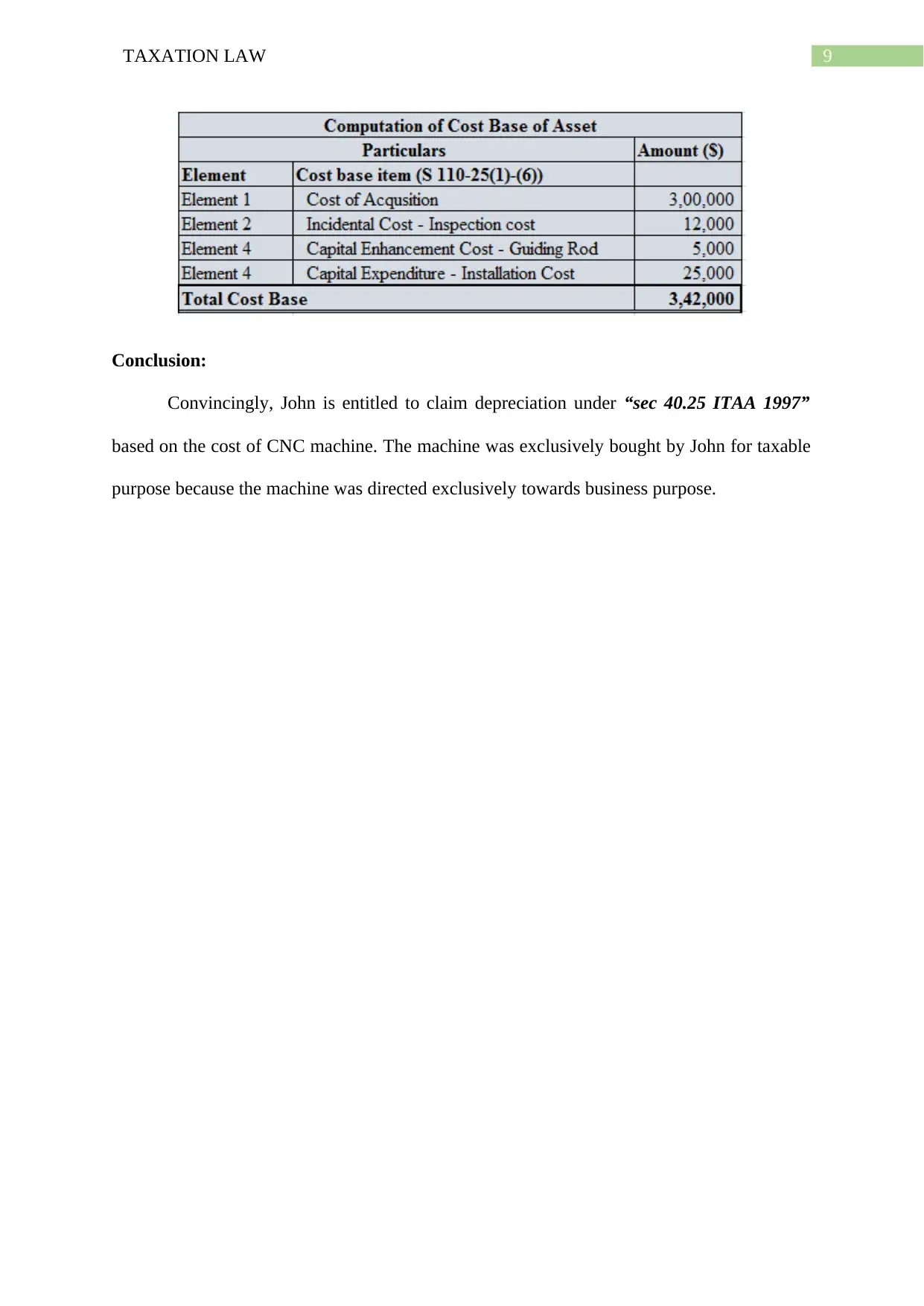
9TAXATION LAW
Conclusion:
Convincingly, John is entitled to claim depreciation under “sec 40.25 ITAA 1997”
based on the cost of CNC machine. The machine was exclusively bought by John for taxable
purpose because the machine was directed exclusively towards business purpose.
Conclusion:
Convincingly, John is entitled to claim depreciation under “sec 40.25 ITAA 1997”
based on the cost of CNC machine. The machine was exclusively bought by John for taxable
purpose because the machine was directed exclusively towards business purpose.
Paraphrase This Document
Need a fresh take? Get an instant paraphrase of this document with our AI Paraphraser
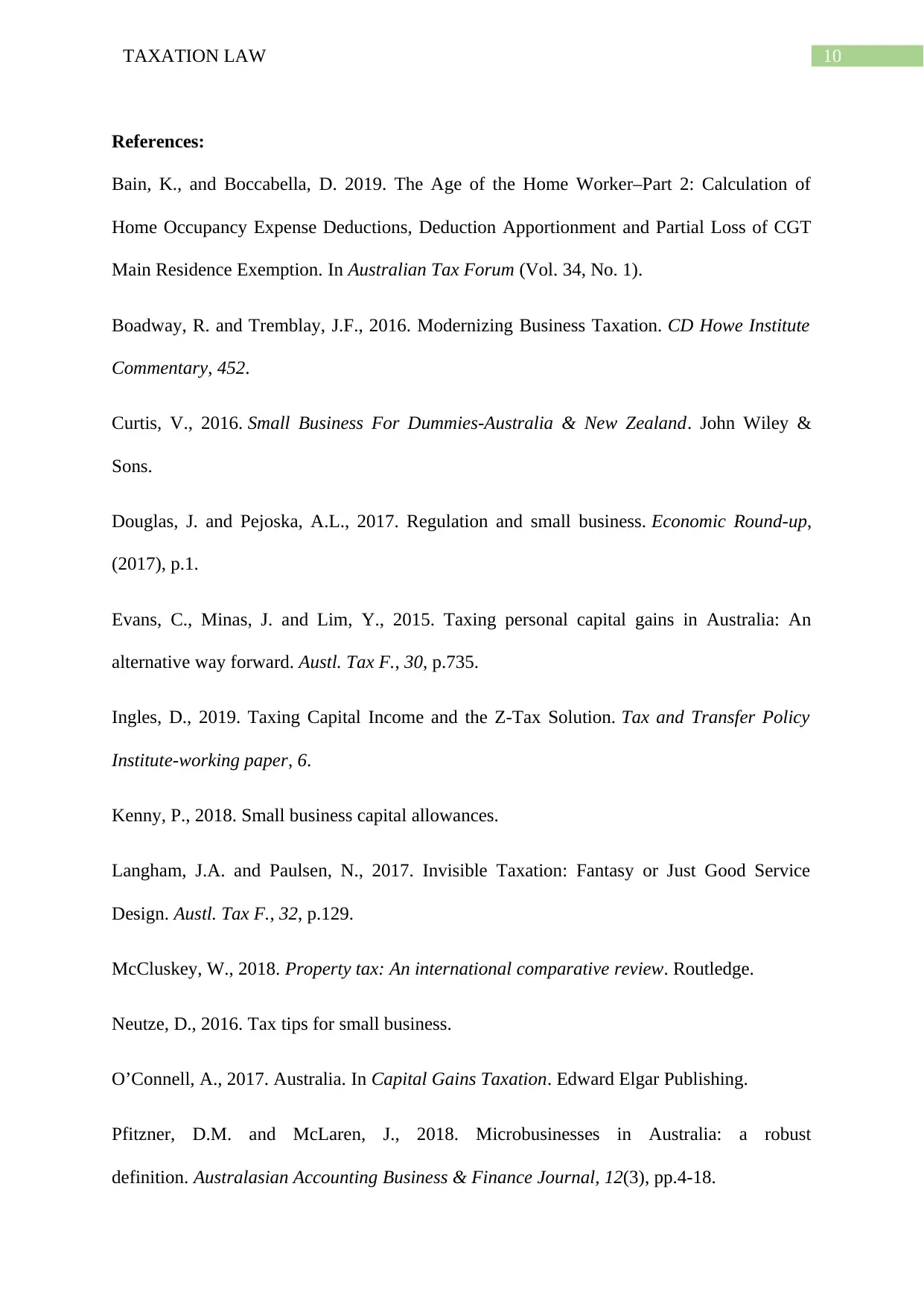
10TAXATION LAW
References:
Bain, K., and Boccabella, D. 2019. The Age of the Home Worker–Part 2: Calculation of
Home Occupancy Expense Deductions, Deduction Apportionment and Partial Loss of CGT
Main Residence Exemption. In Australian Tax Forum (Vol. 34, No. 1).
Boadway, R. and Tremblay, J.F., 2016. Modernizing Business Taxation. CD Howe Institute
Commentary, 452.
Curtis, V., 2016. Small Business For Dummies-Australia & New Zealand. John Wiley &
Sons.
Douglas, J. and Pejoska, A.L., 2017. Regulation and small business. Economic Round-up,
(2017), p.1.
Evans, C., Minas, J. and Lim, Y., 2015. Taxing personal capital gains in Australia: An
alternative way forward. Austl. Tax F., 30, p.735.
Ingles, D., 2019. Taxing Capital Income and the Z-Tax Solution. Tax and Transfer Policy
Institute-working paper, 6.
Kenny, P., 2018. Small business capital allowances.
Langham, J.A. and Paulsen, N., 2017. Invisible Taxation: Fantasy or Just Good Service
Design. Austl. Tax F., 32, p.129.
McCluskey, W., 2018. Property tax: An international comparative review. Routledge.
Neutze, D., 2016. Tax tips for small business.
O’Connell, A., 2017. Australia. In Capital Gains Taxation. Edward Elgar Publishing.
Pfitzner, D.M. and McLaren, J., 2018. Microbusinesses in Australia: a robust
definition. Australasian Accounting Business & Finance Journal, 12(3), pp.4-18.
References:
Bain, K., and Boccabella, D. 2019. The Age of the Home Worker–Part 2: Calculation of
Home Occupancy Expense Deductions, Deduction Apportionment and Partial Loss of CGT
Main Residence Exemption. In Australian Tax Forum (Vol. 34, No. 1).
Boadway, R. and Tremblay, J.F., 2016. Modernizing Business Taxation. CD Howe Institute
Commentary, 452.
Curtis, V., 2016. Small Business For Dummies-Australia & New Zealand. John Wiley &
Sons.
Douglas, J. and Pejoska, A.L., 2017. Regulation and small business. Economic Round-up,
(2017), p.1.
Evans, C., Minas, J. and Lim, Y., 2015. Taxing personal capital gains in Australia: An
alternative way forward. Austl. Tax F., 30, p.735.
Ingles, D., 2019. Taxing Capital Income and the Z-Tax Solution. Tax and Transfer Policy
Institute-working paper, 6.
Kenny, P., 2018. Small business capital allowances.
Langham, J.A. and Paulsen, N., 2017. Invisible Taxation: Fantasy or Just Good Service
Design. Austl. Tax F., 32, p.129.
McCluskey, W., 2018. Property tax: An international comparative review. Routledge.
Neutze, D., 2016. Tax tips for small business.
O’Connell, A., 2017. Australia. In Capital Gains Taxation. Edward Elgar Publishing.
Pfitzner, D.M. and McLaren, J., 2018. Microbusinesses in Australia: a robust
definition. Australasian Accounting Business & Finance Journal, 12(3), pp.4-18.
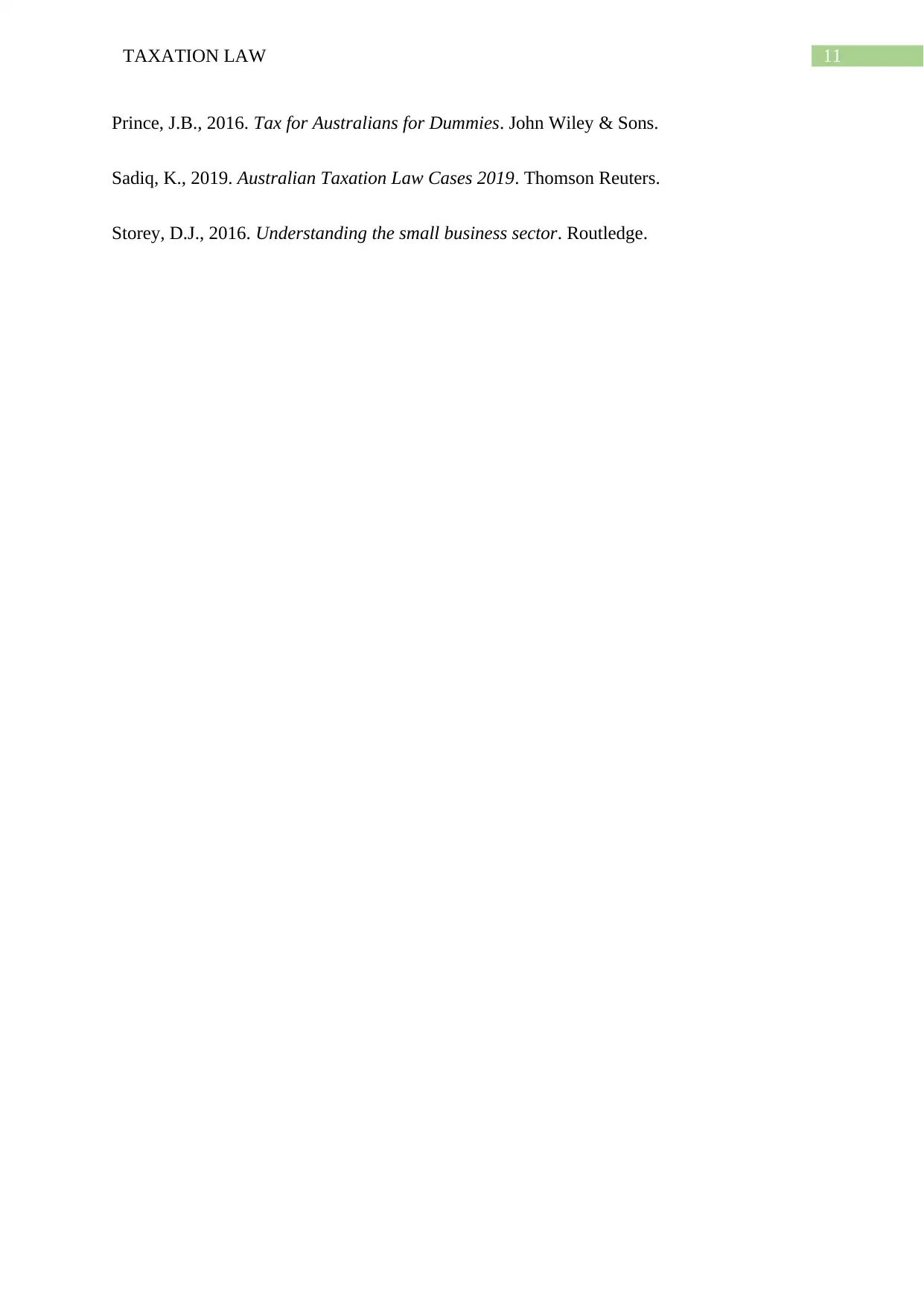
11TAXATION LAW
Prince, J.B., 2016. Tax for Australians for Dummies. John Wiley & Sons.
Sadiq, K., 2019. Australian Taxation Law Cases 2019. Thomson Reuters.
Storey, D.J., 2016. Understanding the small business sector. Routledge.
Prince, J.B., 2016. Tax for Australians for Dummies. John Wiley & Sons.
Sadiq, K., 2019. Australian Taxation Law Cases 2019. Thomson Reuters.
Storey, D.J., 2016. Understanding the small business sector. Routledge.
⊘ This is a preview!⊘
Do you want full access?
Subscribe today to unlock all pages.

Trusted by 1+ million students worldwide
1 out of 12
Related Documents
Your All-in-One AI-Powered Toolkit for Academic Success.
+13062052269
info@desklib.com
Available 24*7 on WhatsApp / Email
![[object Object]](/_next/static/media/star-bottom.7253800d.svg)
Unlock your academic potential
Copyright © 2020–2025 A2Z Services. All Rights Reserved. Developed and managed by ZUCOL.





